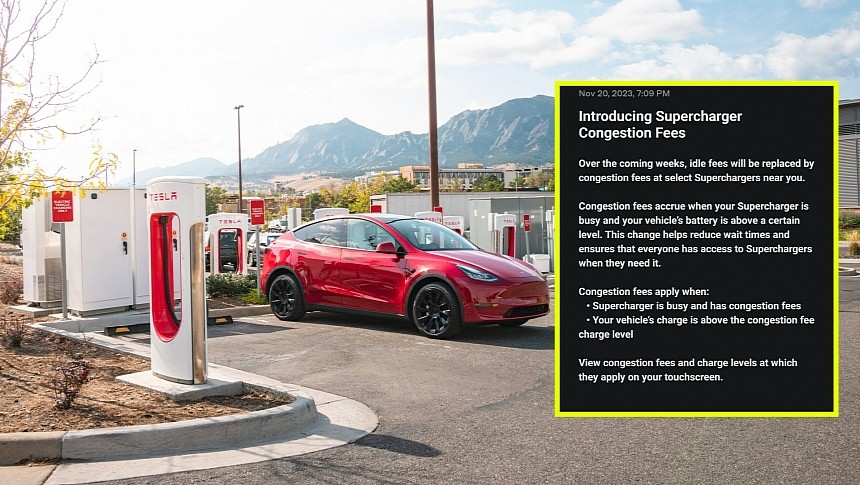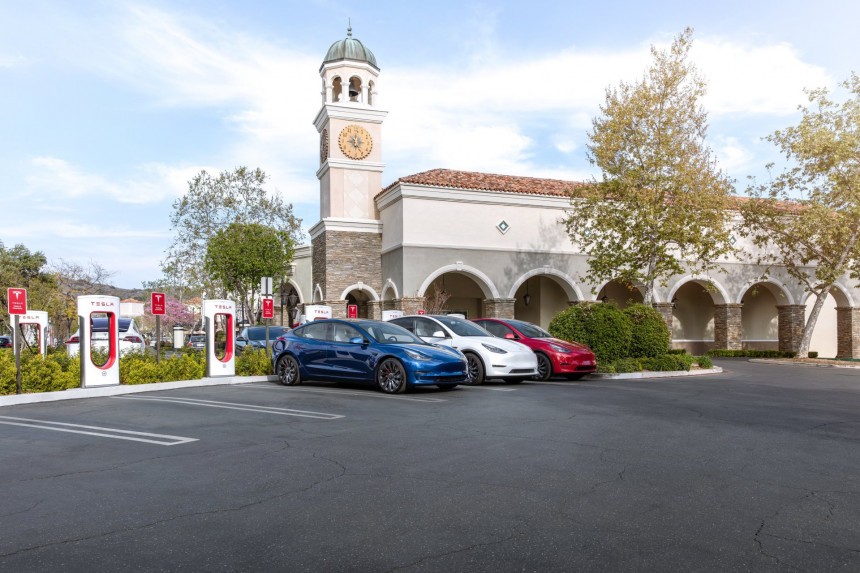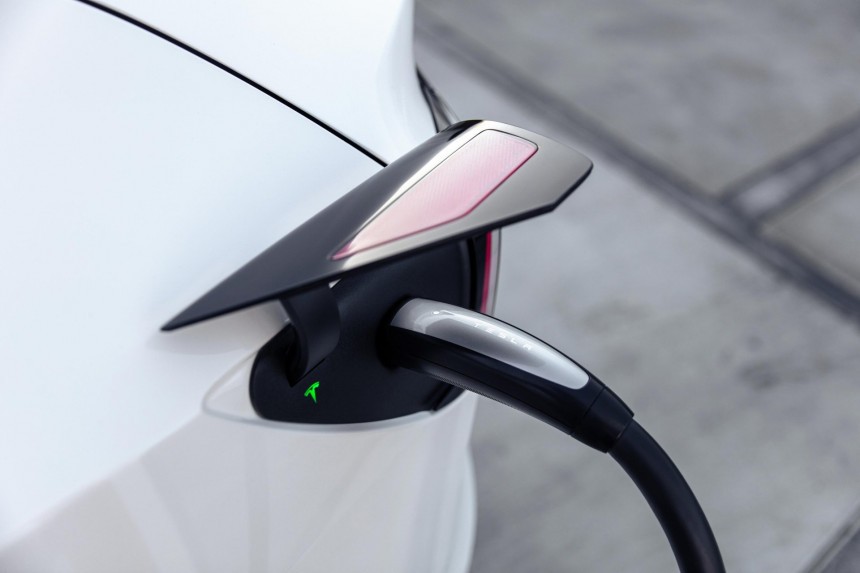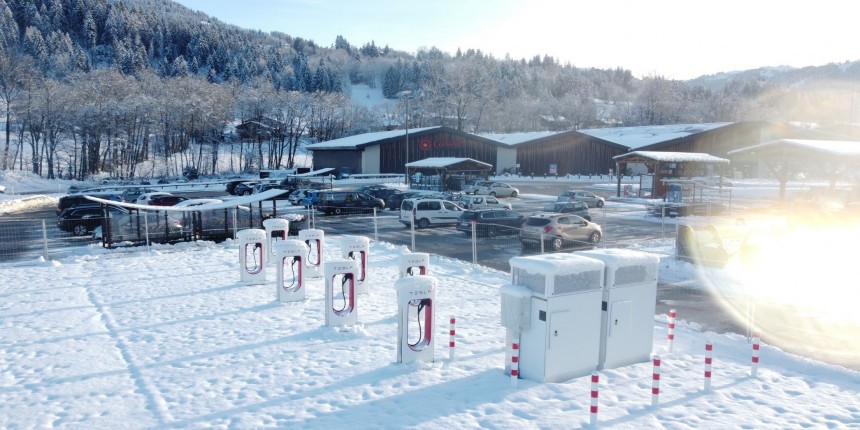When writing, the popular consensus is that there's no better way to fast-charge your battery-electric vehicle than at a Supercharger. Tesla's stalls may not be as powerful as some of Electrify America's 350-kW pedestals, but EV drivers support the theory that the Supercharger network is more dependable. However, pay attention to what the automaker's official app says when hooking your zero-emission car to such a stall. Soon, you may see a different pricing structure. Here's what the congestion fee is all about. But don't get your hopes up. It's Tesla we're talking about here.
Traveling EV owners have one worry: ensuring that the charge level at the start of the journey is enough to reach a high-power dispenser. Fortunately, Tesla implemented a system that analyzes their route and picks the optimal spots for a quick recharging session.
The Texas-based brand's customers usually spend 15 to 25 minutes in such a place to add well over 200 miles of range. But with EVs growing in popularity and the Supercharger network opening up to other automakers who announced the adoption of Tesla's charging port (i.e., the North American Charging Standard (NACS)), some places are bound to become crowded.
But even today, waiting in line to fast-charge your Tesla is a common sight in some parts of the US or a recurring phenomenon.
However, Tesla knows this is happening. It has access to mountains of data. Fortunately, it's not just aware of what's transpiring. It's doing something!
Besides constantly investing in opening new Supercharger stations, the automaker has also applied some clever tactics to sway people away from the busiest high-power charging locations. For example, it made Supercharging free at select stations during high-traffic periods to alleviate the pressure that could have been put on convenient locations.
But that's not guaranteed to work as more EV owners get to use Tesla's high-power charging service.
Hopefully, by then, Electrify America will have fixed its chargers, and the much-anticipated Ionity-like network will be up and running.
But in business, and especially in the automotive industry, hoping for something usually ends in disappointment. So, Tesla is taking action ahead of time by replacing idle fees with congestion fees at some Superchargers.
The EV maker informed its customers about the change via a message sent through the official app. But in true Tesla fashion, it didn't paint a full picture.
The world's most valuable automaker said, "Over the coming weeks, idle fees will be replaced by congestion fees at select Superchargers near you." It didn't provide a list of locations, which could indicate that the brand is still trying to figure out which stations should be a part of this change.
Typically, staying plugged in to reach a 100% state of charge from 80% takes longer than going from 20% to 80%. Automakers engineered this limitation to protect the high-voltage energy storage unit. It's also why most EVs on the road today have buffers that don't allow drivers to deplete the battery.
Tesla told customers that replacing idle fees with congestion fees would "help reduce wait times and ensure that everyone has access to Superchargers when they need it."
Currently, an idle fee of $0.50 per minute applies when your EV's battery is at 100% and the charging station is half full. When every stall is occupied and your vehicle is finished charging up, the idle fee doubles to $1 per minute. Tesla didn't mention if the congestion fee would be higher than the idle fee.
UPDATE. The new congestion fee is set to cost $1 per minute.
People using these select charging stations will have to check the official app and see when electrons get more expensive. So, make sure you're paying attention to the information displayed on your smartphone or infotainment tablet before leaving the car plugged in.
We can't say that's going to be the case. Automakers won't rely solely on Tesla to provide a high-power charging solution. Plus, competitors like Electrify America, EVgo, Francis Energy, ChargePoint, and automakers like Mercedes-Benz or Porsche will try to get some of that charging revenue for themselves.
At the same time, let's not forget the oil industry. Brands like Shell or BP won't just sit around and see their revenue drop as America moves to zero-emission mobility.
Granted, Tesla didn't come up with precise indications about this change. However, it could end up as a good strategy to stop other EV drivers from hogging a Supercharger unnecessarily. Some will surely appreciate not waiting an hour to recharge this Holiday season.
It remains to be seen what impact this measure will have.
The Texas-based brand's customers usually spend 15 to 25 minutes in such a place to add well over 200 miles of range. But with EVs growing in popularity and the Supercharger network opening up to other automakers who announced the adoption of Tesla's charging port (i.e., the North American Charging Standard (NACS)), some places are bound to become crowded.
But even today, waiting in line to fast-charge your Tesla is a common sight in some parts of the US or a recurring phenomenon.
However, Tesla knows this is happening. It has access to mountains of data. Fortunately, it's not just aware of what's transpiring. It's doing something!
But that's not guaranteed to work as more EV owners get to use Tesla's high-power charging service.
Keeping everyone happy
The brand has equipped many stalls with the CCS-to-NACS adapter dubbed the Magic Dock, and it will welcome Ford and GM customers in the spring of 2024 at over 12,000 locations. In 2025, it might get even worse because almost all auto brands present in North America are set to switch to NACS.Hopefully, by then, Electrify America will have fixed its chargers, and the much-anticipated Ionity-like network will be up and running.
But in business, and especially in the automotive industry, hoping for something usually ends in disappointment. So, Tesla is taking action ahead of time by replacing idle fees with congestion fees at some Superchargers.
The EV maker informed its customers about the change via a message sent through the official app. But in true Tesla fashion, it didn't paint a full picture.
A fee-replacing fee
Tesla explained that congestion fees would add up when the Supercharger is "busy" and the state of charge is above a "certain level." Once again, the company doesn't provide clear instructions. However, that could mean Tesla thought of a dynamic pricing strategy. It might apply a congestion fee when all stalls are occupied and you intend to charge over a certain threshold.Typically, staying plugged in to reach a 100% state of charge from 80% takes longer than going from 20% to 80%. Automakers engineered this limitation to protect the high-voltage energy storage unit. It's also why most EVs on the road today have buffers that don't allow drivers to deplete the battery.
Tesla told customers that replacing idle fees with congestion fees would "help reduce wait times and ensure that everyone has access to Superchargers when they need it."
UPDATE. The new congestion fee is set to cost $1 per minute.
People using these select charging stations will have to check the official app and see when electrons get more expensive. So, make sure you're paying attention to the information displayed on your smartphone or infotainment tablet before leaving the car plugged in.
Not great, not terrible
Reactions to this change have been a mixed bag. Some welcomed it, while others said this is just a preview of what Tesla could do once most cars on the road are all-electric, and it has a monopoly on the fast-charging business.At the same time, let's not forget the oil industry. Brands like Shell or BP won't just sit around and see their revenue drop as America moves to zero-emission mobility.
Granted, Tesla didn't come up with precise indications about this change. However, it could end up as a good strategy to stop other EV drivers from hogging a Supercharger unnecessarily. Some will surely appreciate not waiting an hour to recharge this Holiday season.
It remains to be seen what impact this measure will have.



















